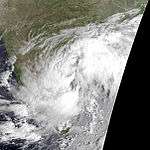1980 North Indian Ocean cyclone season
| 1980 North Indian Ocean cyclone season | |
|---|---|
 Season summary map | |
| Seasonal boundaries | |
| First system formed | October 20, 1980 |
| Last system dissipated | December 17, 1980 |
| Seasonal statistics | |
| Depressions | 5 |
| Deep depressions | 5 |
| Cyclonic storms | 5 |
| Total fatalities | Unknown |
| Total damage | Unknown |
| Related articles | |
The 1980 North Indian Ocean cyclone season was part of the annual cycle of tropical cyclone formation. The season has no official bounds but cyclones tend to form between April and December. These dates conventionally delimit the period of each year when most tropical cyclones form in the northern Indian Ocean. There are two main seas in the North Indian Ocean—the Bay of Bengal to the east of the Indian subcontinent and the Arabian Sea to the west of India. The official Regional Specialized Meteorological Centre in this basin is the India Meteorological Department (IMD), while the Joint Typhoon Warning Center (JTWC) releases unofficial advisories. An average of five tropical cyclones form in the North Indian Ocean every season with peaks in May and November.[1] Cyclones occurring between the meridians 45°E and 100°E are included in the season by the IMD.[2]
Systems
Tropical Storm One (1B)
| Tropical storm (SSHWS) | |
.jpg)  | |
| Duration | October 10 – October 20 |
|---|---|
| Peak intensity | 65 km/h (40 mph) (1-min) |
The first storm of the season began its life on October 10 in the Bay of Bengal. It executed an anticyclonic loop to the west, and became a tropical storm before hitting eastern Sri Lanka on the 17th. It continued westward, and ultimately dissipated over the Arabian Sea on the 20th.
Unknown Two (2B)
  | |
| Duration | October 16 – October 19 |
|---|---|
| Peak intensity | Winds not specified |
On October 18, a storm of unknown intensity hit eastern India, dissipating the next day.
Tropical Storm Three (3A)
| Tropical storm (SSHWS) | |
  | |
| Duration | November 12 – November 19 |
|---|---|
| Peak intensity | 65 km/h (40 mph) (1-min) |
The monsoon trough spawned a tropical depression off the western Indian coast on November 12. It tracked generally northwestward, slowly organizing into a tropical storm on the 17th. The storm turned to the northeast, where it dissipated over the northeastern Arabian Sea.
Tropical Storm Four (4B)
| Tropical storm (SSHWS) | |
  | |
| Duration | December 3 – December 7 |
|---|---|
| Peak intensity | 65 km/h (40 mph) (1-min) |
A storm of unknown intensity persisted in the western Bay of Bengal from December 3 to the 7th, remaining well offshore of any landmass.
Tropical Storm Five (5B)
| Tropical storm (SSHWS) | |
  | |
| Duration | December 12 – December 17 |
|---|---|
| Peak intensity | 100 km/h (65 mph) (1-min) |
The last storm of the season formed in the central Bay of Bengal on December 12. It moved east-southeastward, then turned to the west where it briefly became a tropical storm. The storm struck eastern Sri Lanka, and dissipated over the island on the 17th.
See also
- List of North Indian Ocean cyclone seasons
- 1980 Atlantic hurricane season
- 1980 Pacific hurricane season
- 1980 Pacific typhoon season
- Australian cyclone seasons: 1979–80, 1980–81
- South Pacific cyclone seasons: 1979–80, 1980–81
- South-West Indian Ocean cyclone seasons: 1979–80, 1980–81
References
- ↑ "Frequently Asked Questions: What is the annual frequency of Cyclones over the Indian Seas? What is its intra-annual variation?". Indian Meteorological Department. 2012. Archived from the original on May 21, 2015. Retrieved June 8, 2012.
- ↑ "Bulletins Issued by Regional Specialized Meteorological Centre (RSMC) - Tropical Cyclones, New Delhi" (PDF). India Meteorological Department. May 25, 2009. Retrieved July 16, 2012.